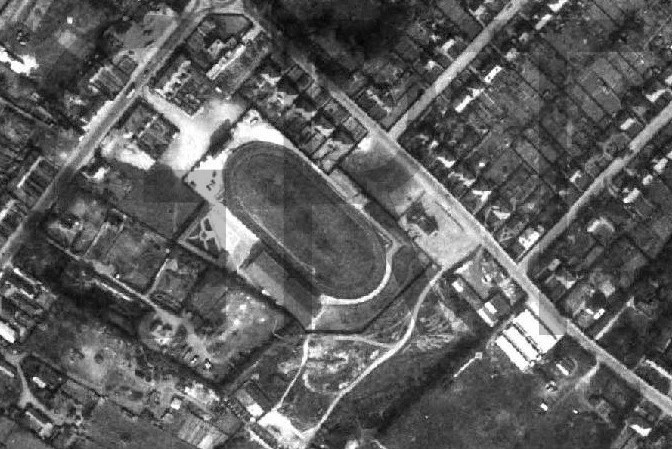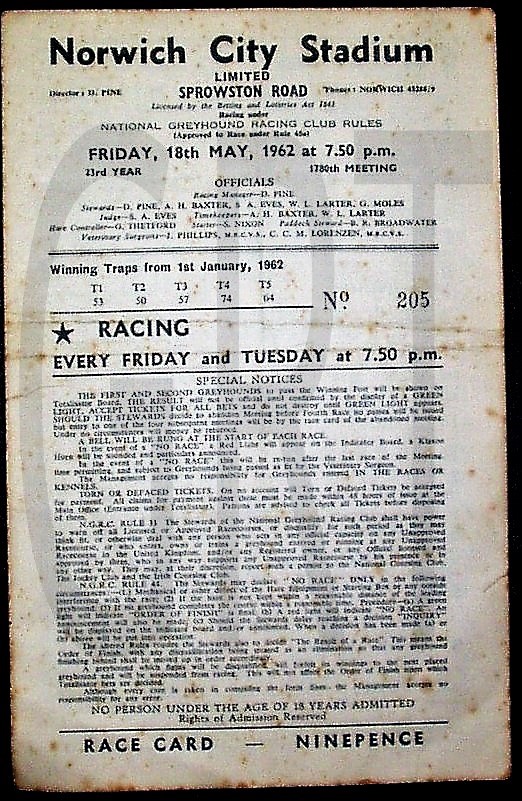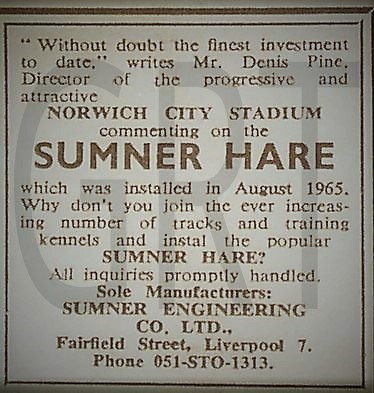Sprowston Road, Shipfield, Norwich, Norfolk.
POSTCODE———————————-NR3 4EQ
LOCATED————————————About one and a half miles north east of Norwich city centre, the entrance to the stadium was of the A1042 Mousehild Lane opposite Alford Grove very closer to the junction with the A1151 Sprowston Road.
ORIGINAL SITE—————————–An old Brickworks.
DATE CONSTRUCTED——————–1938
DATE VENUE OPENED——————-July 1939.
Meaning other sports may have taken place prior to the arrival of Greyhound Racing.
FIRST MEETING—————————–July 15th 1939.
Greyhound Racing only.
LICENSED OR INDEPENDENT———-NGRC.
All venues covered would have to be licensed with the government, licensed suggested in this section would refer to tracks operating under NGRC Rules.
INSIDE OR OUTSIDE HARE TYPE——Originally the McWhirter type then Inside Sumner which was installed during 1965.
Please note that the Electric Hare suggested is only a guidance and would have been in operation for a certain amount of time at this venue. Although it is not necessarily guaranteed that it was operational all the time, as other types of lure may have been used and updated as time progressed.
DISTANCES———————————–333, 400 and 555 yards.
Please note that most racing venues distances had become varied throughout the years, the ones given above were at once point set and offers only a guidance to the track size.
CIRCUMFERENCE—————————When it first opened it was 322 yards making it the smallest distance under NGRC Rules. This figure may have altered later in 1965 after the track was widened.
Please note that alterations at most racing venues throughout its existence would see that the circumference of the track would vary, the one shown above offers only a guidance to the track size.
BIG RACE NAMES—————————Nothing found.
STADIUM SHARED WITH——————Nothing known of.
LAST MEETING——————————-August 7th 1971.
Greyhound Racing only.
STADIUM CLOSURE DATE—————-August 1971.
Meaning other sports may have taken place after Greyhound Racing had ceased.
STADIUM DEMOLITION——————-Early 1970’s.
BUILT ON SITE——————————-Houses on Templemere now covers the site.
In some cases, structure’s that originally covered the venue after the stadium had been demolished, may have been themselves demolished too, so the one described is more likely to be the one which now presently covers the site.
EVIDENCE LEFT TODAY——————-There is some faint paintwork on the gable end of a terraced house along Sprowston Road, with the words Totalisator and Greyhound clearly evident.
FURTHER COMMENTS——————–None






It would be difficult to convince the youth of today that the city of Norwich had witnessed Greyhound Racing at four different venues. This section describes not only the last one that opened, but also the last one that closed.
That stadium was situated just off Sprowston Road, and became more recognised to its patrons as the City Stadium, which was situated in the district of Shipfield, roughly one and a half miles west of Norwich city centre. Construction began in 1938 on the site of an old brickworks, but the small section of land left, once the car parks and stands had been constructed, restricted the circumference of the track to just 322 yards, becoming the smallest of all NGRC tracks in operation.
Its opening meeting came on the 15th of July 1939, with an impressive 10,000 racegoers in attendance, who witnessed a greyhound called Grangemore Lad win the first ever event. Races were made up of five greyhounds challenging over distances of 400, 555 and 715 yards, with the hounds chasing a trackless McWhirter type hare. Yet within a matter of weeks of its opening, the closure off greyhound tracks were enforced across the country, this due to the declaration of the Second World War, but again the City Stadium was allowed to continue once regulations had been reviewed.
In 1965 the old McWhirter type hare was replaced by the outside Sumner type, a period which also saw the track widened, but also saw a reduction in distances to just 333, 400 and 555 yards. By the turn of the 1970’s, the numbers through the turnstiles began to dwindle, and again like Norwich’s Boundary Park track that closed in 1962, the City Stadium was operating at a loss. But in 1971, strange events were about to unfold as the tracks closure came out of the blue. Unknown to trainers and racegoers, the final meeting happened to be on the Saturday evening of 7th of August. First news of its closure was when the trainers were informed the following morning, and then more publicly, when Tuesday’s programme was printed in the local press, along with the words “Meeting Cancelled”.
It soon became clear that the City Stadium had been sold to developers, who had been given permission to construct a modern housing estate on the site. Nothing remains of the venue today, as the site is now covered by houses on either side of an access road called Templemere, which is accessible from the A1151 Sprowston Road, just before the junction with the A1042. Just to note that the access to the stadium at the time, was off Sprowston Road between two rows of terraced houses less than a hundred yards from the roundabout.
Today, no access is possible, but the area at the rear of these houses, once served as the main car park to the track’s entrance, which now acts as foundations for a cluster of privately owned car garages. Luckily enough evidence of the stadium’s location still exists, with the faint words of Totalisator and Greyhound seen fading on the gable end of a terraced house along Sprowston Road.
A programme, photograph or even memorabilia for this track is required for this page, if you can help please contact me.

Recent Comments